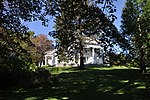Stissing Mountain
Mountains of Dutchess County, New YorkMountains of New York (state)
Stissing Mountain, with an elevation of 1,403 feet (428 meters), lies in northern Dutchess County, New York, where it rises about 1,000 feet (305 meters) above its local footings. The mountain is steepest on its eastern slopes, which average 40 percent (or 21.8 degrees). This eastern escarpment is about 3 miles (4.8 km) long. Around Stissing's eastern base are substantial amounts of talus blocks composed of gneiss. A restored, 1933 fire tower is near the summit and open to the public (as of 2023) via hiking trails.
Excerpt from the Wikipedia article Stissing Mountain (License: CC BY-SA 3.0, Authors).Stissing Mountain
Red trail,
Geographical coordinates (GPS) Address Nearby Places Show on map
Geographical coordinates (GPS)
| Latitude | Longitude |
|---|---|
| N 41.9564812 ° | E -73.6926279 ° |
Address
Red trail
Red trail
12567
New York, United States
Open on Google Maps




